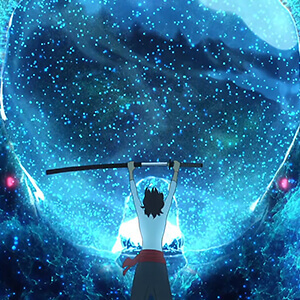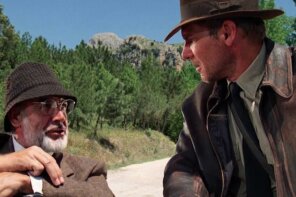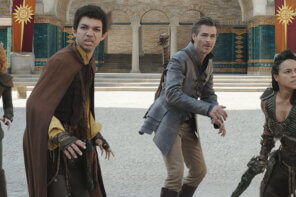American animated films tend to be formulaic slapstick. Of course this is Disney’s fault, but it’s also because we consider cartoons to be “for children,” therefore they must be easy to grasp and funny and sentimental. I would argue American animation labors under the same existential curse most adolescent entertainment does: sarcasm and narcissism disguised as a kind of winking savvy (I dare you to watch Disney’s teen programming and not openly weep).
The Boy and the Beast, Mamoru Hosoda’s latest animated fantasy, has more to offer a family audience willing to sit through a sometimes scary, sometimes impenetrably Japanese story. Hosoda explores what it’s like to teach and be taught, how hate can grow within and overpower us, and what it means to find a place when you have no roots.
At Home in the Land of Beasts
9-year-old Ren is in the throws of grief over the death of his mother and the abandonment of his father. In a fit of rage Ren runs away from his relatives and takes to living in the streets of Shibuya district, Tokyo. Filled  with despair, Ren gives voice to his hate, calling forth a powerful shadow spirit. Before this spirit consumes him, Ren finds himself mysteriously drawn into another world where he comes under the tutelage of a Beast.
with despair, Ren gives voice to his hate, calling forth a powerful shadow spirit. Before this spirit consumes him, Ren finds himself mysteriously drawn into another world where he comes under the tutelage of a Beast.
The Beast, Kumatetsu, must take on an apprentice in order to prove his worth: he is competing to become the next Lord of Beasts in this strange land. Ren spends eight years in the beast world apprenticed to Kumatetsu until he stumbles back into our world and decides to stay. On his return he must face his own hatred, festering for the last eight years, as well as that of another boy (Ichirohiko) who harbors resentment towards Ren.
Overcoming the Spirit of Hate
In Japanese folklore supernatural beings called yokai can come in to existence via human emotions like jealousy, sadness, and hate (see 2002’s Japanese crossover hit Ju-on: The Grudge for more). In Ren’s case he struggles against his hate while Ichirohiko allows it to literally consume him and take the form of a violent and destructive power. “Your hate has made you powerful!”  the Emperor tells Luke in Return of the Jedi, and we do seem to summon a hideous strength by focusing our hatred. Jesus says our hate is equivalent to murder: when we choose to give in to its power, humanity is capable of the very worst atrocities.
the Emperor tells Luke in Return of the Jedi, and we do seem to summon a hideous strength by focusing our hatred. Jesus says our hate is equivalent to murder: when we choose to give in to its power, humanity is capable of the very worst atrocities.
In this sense fantasy has little to say that we haven’t already enacted in reality. Too often fantasy defeats violence with more violence and the cycle continues until either everyone is dead or some force achieves total victory. Modern fantasy tends to lean towards grim realism, but Hosoda takes us in a different direction: Hatred is overcome by self-giving love. The master gives his life for the student and Ichirohiko is restored rather than defeated.
Like Fathers, Like Son
As a secondary theme, Hosoda investigates family relationships. This is a huge theme for him. In Wolf Children he explores how families change when children grow up, and in Summer Wars he looks at how families unite during tough times because of their shared past. In The Boy and the Beast Ren’s relationship with his absentee father takes center stage. Kumatetsu becomes a surrogate father for eight years, but Ren never forgets his lost father. Their eventual reunion is awkward and messy. Ren can’t figure out where he fits between his nervous, salaryman biological father and his hot-tempered, warrior beast-father.
The animation is beautiful, with the characteristic Hosoda look. The fight choreography is well done, and I love the hybrid man-beast creatures. The story is not as fully-realized as Wolf Children or Summer Wars, and I found the eight year gap in the narrative particularly jarring (even with a brief training montage). Hosoda tries to shoehorn in a love interest for Ren which feels stock and flat. In spite of this, it’s still an engaging and funny story. It’s a fantasy that reminds us we can choose whether or not our desires consume us and gives a hopeful vision of hate being redeemed by love.





